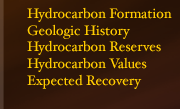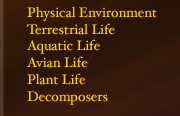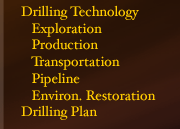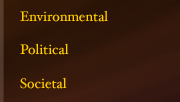
Terrestrial Life - Porcupine Caribou (Rangifer tarandus)
General Information
The porcupine caribou herd can be located at many plant communities throughout
ANWR. The herd is made up of an estimated 129,000 members and spends winters
in the southern portion of the refuge (as well as outside of refuge). The
herd migrates twice a year more than 700 miles to ANWR's Coastal Plain. The
pregnant cows normally reach the calving areas in the Coastal Plain by early
June and give birth. (Hank Lentfer and Carolyn Servid, 2001). Soon afterwards,
the rest of the herd joins the cows in their calving ground. About
a month afterwards, when the climate gets slightly warmer and mosquitos hatch,
the caribou will migrate north seeking relief from these tormenting insects.
They will travel along the coast, and to the uplands in Brook's Range. (Kaj
Birket-Smith)
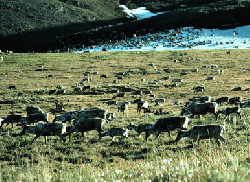
Porcupine Caribou Herd
(Photo: http://www.r7.fws.gov/nwr/arctic/caribou.html)
Critical Time Periods
Between the months of August and October insects are less abundant, the caribou still travel in search of nutrition but do not have the need to congregate in areas where swarms of insects can be avoided. (Lentfer and Carolyn Servid, 2001) Therefor, the caribou disperse widely and cover a large area but along parallel paths. By October, the Porcupine caribou herd has moved to the boreal forest. The critical time period for the caribou is when migrations is at its greatest in April and during the first week after the calves are born. The cows are the first to arrive to the Coastal Plain (USGS Fish and Wildlife, 2003) and 1002 region and normally arrive in early June although harsh weather conditions can delay their arrival. The most critical time period is in the calves first week in the world.
The Coastal Plain is vital to the calves’ survival for two main reasons:
1) fewer brown bears, wolves, and golden eagles live on the coastal plain so newborns have greater chance of survival in their first week until they are strong enough to outrun their predators. (USGS Fish and Wildlife, 2003)
2) Coastal Plain provides proper nutrition needed for calving. There is an abundance of plant species and after a long winter, the cows need to have good nutrition
Calving grounds:
the northern foot hills of the Brooks Range and the arctic Coastal Plain from from the Tamarayiak River in Alaska to the Babbage river in Canada. Most often used calving grounds are on the Coastal Plain between the Katakturuk and Kongaut rivers where normally, 50% - 75% of the herds' calves are born.
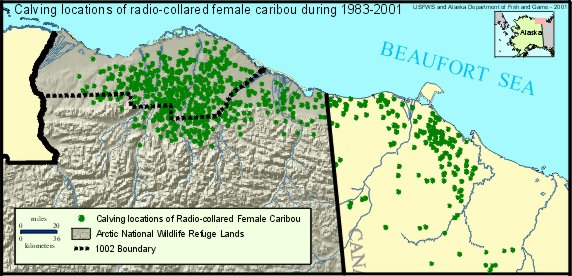
Calving Locations of Radio Collared Female Caribou
(Map: http://www.r7.fws.gov/nwr/arctic/caribou.html)
Proposal
The porcupine caribou herd are a vital part of ANWR's eco-system and therefore must be taken into great consideration when planning the most environmentally efficient way to extract oil . The porcupine' caribou herd's relation to the Coastal Plain is part of an unaltered system which brings new life to the Caribou after a long and harsh winter.
It is vital to take into grave consideration the migratory paths of the Porcupine Caribou Herd before formulating a plan to extract oil. Precautions should be made with utmost carefulness in order to mitigate as much as possible the effects on the herd's migratory paths which have gone undisturbed for centuries.
Suggestion
The fact that this important species is migratory is a major asset in formulating an environmentally efficient method of oil extraction. The oil drilling should occur between the months of October and April when the the caribou are not in the 1002 area.
Caribou's Migratory Paths: Map
(Map: http://www.r7.fws.gov/nwr/arctic/caribouyear.html)
Reference:
1. Hank Lentfer and Carolyn Servid. (2001). Arctic refuge
: a circle of testimony . Minneapolis, Minn. : Milkweed Editions, 2001.
2. Joe C. Truett and Stephen R. Johnson. (2000). The
natural history of an Arctic oil field : development and the biota. San
Diego, Calif. : Academic, c2000.
3. Kaj Birket-Smith. (1976). The Caribou Eskimos : material
and social life and their cultural position. New York : AMS Press
4. http://www.r7.fws.gov/nwr/arctic/wildlife.html
5. http://www.absc.usgs.gov/1002/index.htm

